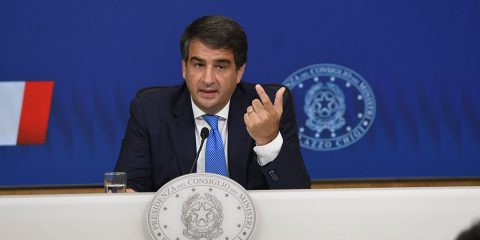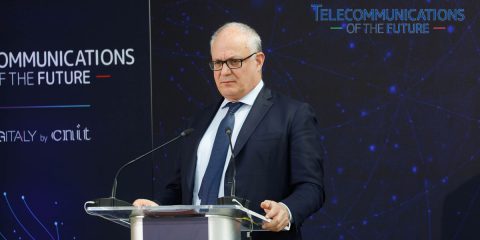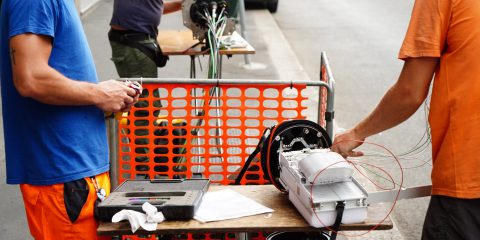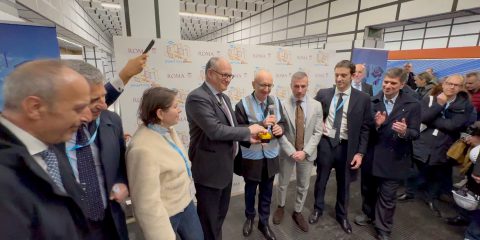Europa

Lo stato dell’arte dell’industria europea delle telecomunicazioni, la regolamentazione, gli obiettivi fissati dal Commissario Ue Neelie Kroes nella Digital Agenda e la necessità di accelerare sul mercato unico per le tlc sono i temi al centro dell’intervista rilasciata dal presidente del board ETNO Luigi Gambardella, tra i key speaker del Telecoms Regulations Forum in corso a Londra.
What is your view about the current state of the European telecommunications industry? What changes do you think are needed to revive growth in the sector?
Gambardella. Our sector has been affected by an ongoing declining revenue trend over the past years, undermining the investment capacity of operators. Between 2007 and 2011, the aggregated turnover of European network operators has shrunk by 8%. As a consequence, Europe’s share of global telecoms market has reduced from 31 to 25%. Moreover, early estimates for 2012 show a revenue drop by 3%.
However, in 2011 and 2012, investments in new networks and services, mainly driven by ETNO members, have continued to increase. This shows our commitment to long-term investment in innovative networks and to the achievement of Digital Agenda goals.
But if we want to keep investing in state-of-the-art infrastructures and services for European citizens, we cannot act alone. The institutions could play a key role as well, by making the regulatory framework more investment-friendly, stable and forward-looking.
Could this negative trend be the result of the extremely difficult conjuncture of the EU economy? Or do you see more structural problems underlying it?
Gambardella. This is a very important question. Of course the European economic crisis is putting internal demand under strain, with negative repercussions on the industry as a whole.
Nevertheless, we believe that the main problem is structural, and not cyclical. It is worth noting that Europe’s telecoms market is the only market in the world to register a revenue loss. Between 2006 and 2011, the revenues of Asian and North American telecom sectors have been increasing respectively by 72% and 56%. This clearly signals that, at the global level, the sector is not struggling. It has great potential for growth. But this potential is not being exploited within the EU, due to a regulatory framework which is not well-suited to foster competitiveness at the global level, which is now what operators really need.
In your opinion, what are the actions to be prioritized at the regulatory level?
Gambardella. We believe that three conditions in particular need to be in place for operators to get back to a path of solid and sustained growth:
First, operators must be able to achieve a greater scale for the development of their services. In this regard, the recent calls by the European Commission and the European Council for a single market for telecoms are a promising step. As of now, the European market is too fragmented, compared to other regions. In the EU there are over 1200 fixed telecom operators and over 100 MNOs. At the same time, in the US there are only six major operators, and in China only three.
Second, the regulatory approach has to evolve further in order to encourage investment in high-speed broadband networks. Vice-president Kroes’ new approach to fibre regulation, if implemented in the right way, can be a first step in that direction.
Finally, as telecoms operators increasingly compete with over the top players, it is essential to achieve a level playing field allowing the telecoms operators to operate on an equal footing.
How far are we from the achievement of Digital Agenda targets? Do you think they are still achievable?
Gambardella. Latest data show that, although Europe is getting closer to Digital Agenda targets, they still remain a major challenge.
95.7% of homes are already passed with at least one fixed broadband network. With the combined use of wireline and wireless technologies and platforms, the target of providing all households with a basic broadband connection by 2013 will be achieved. As far as the 2020 targets are concerned, half of European households have access to a 30 Mbps connection (target: 100%). However, only 2% of households have subscriptions to 100 Mbps (target: 50%).
To proceed further, and faster, Europe needs more private investments. This is the only way forward. But investments are unlikely to come if the regulatory and policy framework does not guarantee reasonable returns, stability and attractive conditions. This is why we are calling for a change, in the interest of citizens, consumers, operators, and of the EU economy as a whole.
What are the latest technological developments in deploying fixed and mobile broadband?
Gambardella. As recognized by the European Commission, all technologies capable of providing high speed broadband access should be fully exploited, including wireline (copper networks through vectoring, cable, fibre) and wireless (LTE).
The role of copper networks, through the use of vectoring technology, should not be underestimated. This technology is being chosen by several operators in Europe and beyond (recently also chosen in China), as a way of accelerating the deployment of high speed broadband.
Mobile networks will play a key role to provide mobile data services which are increasingly capable, thanks to LTE, of speeds comparable to the fixed network. Wireless will also potentially play a special role in those areas where investment in fixed networks might not be economical. It is therefore essential to get the spectrum policy right. The 800 MHz band should be made available everywhere as per the Radio Spectrum Policy Programme. But the EC should push further. 5G trials are already underway in Asia, with nominal speeds of up to 10 Gbit/s. Europe should not fall behind in wireless technology.
Additional spectrum must be made identified and an overarching, pan European strategy for the whole UHF spectrum is urgently needed .
What is your view on the proposed new approach to access regulation, envisaged by Vice-President Kroes?
Gambardella. The rapidly changing realities in market and technologies call for a radical shift in the EU regulatory approach in order for operators to continue to invest and develop new business models.
ETNO welcomed the new approach to EU price and access regulation that VP Kroes outlined in her announcements of July 12. Stable wholesale prices and price flexibility for fixed NGA will help the industry making available the funds for investment in next generation broadband networks. Price flexibility must also be supported by the new ‘economic replicability’ test. ETNO calls for an improvement of the recommendation in this respect (s. Q on the Rec. above).
But the new Commission approach to fibre regulation can only be a first step, which must be followed by a bold deregulatory move in the context of the recommendation on relevant market: regulation should fully take into account competitive pressure from alternative broadband platforms, representing already today 48% of available NGA, and web-based applications. It should target uncompetitive areas, and focus on real bottlenecks. In the medium term, this necessitates a full review of the framework.
We now need to see this new approach to be implemented in the forthcoming regulatory initiatives of the European Commission.
What could be the eventual impact of a European Commission recommendation on cost methodologies to incentivize fibre roll-out?
Gambardella. The regulatory framework is a key aspect influencing investment decisions. Regulatory uncertainty adds to uncertainty linked to demand. Regulation can play a role to allow a better return on investment, and improve the case for NGA roll-out. In this context, the announcement by Vice President Kroes of a new approach to broadband regulation in July of last year has sent an important signal to the investors’ community, which now needs to be reflected in the forthcoming recommendation:
The stability of current copper wholesale prices will enable to maintain the investment capacity of ETNO Member companies, help preventing further price erosion in the sector and foster the willingness of consumers to switch to high speed networks.
Price flexibility for fixed NGA wholesale products is essential for introducing new advanced services, especially in the current economic climate. Wholesale access obligations at cost-oriented prices do not give enough flexibility to operators to develop differentiated offers tailored to consumer needs. In this context, it is essential that any margin squeeze test applied to NGA products allows for effective risk sharing arrangements and takes into account the investor’s business case, in particular the need to recover its fixed costs over a long time period.
Non-discrimination: ETNO members are committed to ensuring non-discriminatory access but the approach to achieve non-discrimination should be proportionate and should minimize associated costs.
The impact of the new approach will also depend on the readiness of NRAs to change their current practice in a pro-investment logic. Regulatory approaches that may have worked in a copper world are no longer appropriate in an NGA environment.
Should policy makers favor infrastructure competition or a ‘single network’ plan?
Gambardella. There’s no ‘either or’. Infrastructure competition between different network platforms is already a reality in many parts of the Europe. 48% of NGA access today is provided by alternative platforms. The structure of the market should not be determined by policy but should be led by market needs.
Will entrants be the real winners in the fibre race?
Gambardella. First of all, we believe that the real winners of the next generation access environment should be the consumers and the economy as a whole. Ultimately the transition towards NGA will lead to more competition and more choice for consumers. The real winners will be those players who are investing and taking a share of the risk.
What technological and behavioral changes are creating future regulatory challenges?
Gambardella. What we witness today is a radical shift in the competition paradigm. Traditional telecoms operators, be they well established or entrants, are competing more and more with new Internet players, often based outside of the European Union, who are providing applications which consumers are increasingly using for their day to day communications needs. Value is shifting to these players while they are not subject to the same regulatory burden. In addition to that, web-based applications are replacing the traditional telephony services (think Whats App and Skype) in consumer’s preferences. This increased competition from OTTs and web-based applications needs to be taken into account when considering the future of the EU regulatory framework. This type of competition will lead necessarily in the future to further deregulation of traditional operators.
Why is a Single Market for telecoms needed?
Gambardella. European telco’s revenue growth is 7 to 9 times lower than in Asia and North America. European Telco’s value on markets has shrunk by 28% between 2006 and 2012 while worldwide market capitalization of Internet companies has increased by 101%. It is urgent to enable operators to develop new business models in order to reverse these trends and be able to sustain investment level.
One of the reasons behind this trend is linked to the high fragmentation of the European telecoms sector compared to other regions of the world, especially the US or Asia. A single market would benefit consumers and increase Europe’s competitiveness. The absence of an EU single market for telecoms services is partly due to the lack of consistency in rules such as data privacy obligations and the fragmentation of copyright and licensing systems for online content and services.
Barriers to consolidation and horizontal cross-industry cooperation are deterrents to investments in the sector. Less fragmentation could help to achieve a Single Market and increase the competitiveness of the EU telecoms sector on the global scene. A less fragmented, more competitive European industry, through its better capability to invest, would provide Europe with world-class infrastructure, enabling economic growth, productivity gains as well as continuing to contribute to Europe’s welfare.
There is an immediate need for leadership from European policy makers to enable network operators to reach scale and horizontal cooperation for standardization. With scale, the European industry would have the negotiating power which it lacks currently on the global level, and this could also trigger innovation.
A single market would encourage the development of innovative services and applications and put operators in a better position to compete with over the top players.












